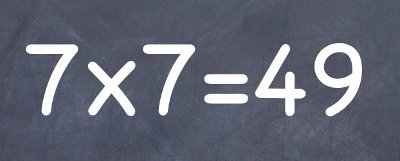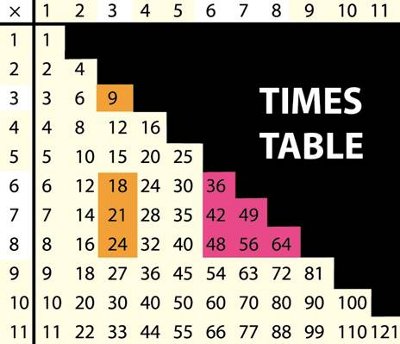The times tables they are a-changin’
by Burkard Polster and Marty Ross
The Age, 22 March 2010

Has everyone done their homework and perused the draft National Mathematics Curriculum? We have. As you may know, we found much that caused us to shake our heads and groan in despair. We've had our say, and now we hope to get out of the way, and simply watch as this trouble-ridden Titanic sails off to its fate.
And we'll do that. But first, in the next few columns, we want to share with you some of what we've learned from studying the draft curriculum.
One thing we learned is that the expression "times tables" is forbidden. In its place there is continual reference to "multiplication facts". For example, one of the goals is for year 4 sudents to:
Understand and become fluent with multiplication facts and related division facts of 2, 3, 5, and 10 extending to 4, 6, 8, and 9.
Ignoring the fact that this sentence is ungrammatical and clumsy, we were puzzled by the curious exclusion of the number 7. Pondering it, this exclusion appears curiouser and curiouser.
The plan is for year 4 students to be able to multiply by 1 (presumably), 2, 3, 4, 5, 6, 8, 9 and 10. So they will also know 1 x 7, and 2 x 7, and so on? Then, all that will be missing is a single maligned multiplication, poor old 7 x 7.
We honestly have no idea what the curriculum writers were thinking. Refer to "multiplication facts" if you wish, but these facts fit perfectly into one table, a table that students simply must know by heart. And why all this verbiage amounting to "don't teach 7 x 7"?
Clearly the draft curriculum is reflecting some fear of times tables, but why? How hard are they really?
Burkard's daughter Lara is in year 2, attending a local government school. A few of Lara's classmates have known their times tables for a while, and Lara was frustrated at being slower with the answers. So, Daddy Maths Master was called upon to help.
It took about three weeks to fix the problem: about 15 minutes a day of making connections and playing maths games. Lara is now pretty solid at all the times tables up to 11. (The draft curriculum doesn't include multiplication by 11, but Burkard promises to unteach Lara when the time comes).
Impossible, you say? We doubt it. Lara is not a little genius; just about everything she learns is just on the school's schedule, or a bit slower. And Daddy Maths Master didn't wave any magic mathematical wand.
At first glance, mastering the times tables up to 11 seems a formidable task: that's 11 x 11 = 121 products to learn. But of course N x M = M x N, and so you only need to learn a few more than half that number.

That's still a lot of products, but many are easy to practise if presented in a clear and suitable manner: the 1 x, 2 x (double), 4 x (double double), 10 x, and 11 x tables offer few difficulties. The 5 x table is trickier, but of course the product always ending in 0 or 5 helps a lot. There is also a finger trick that makes the 9 x table really easy. (If you don't know this finger trick then you absolutely must rent the terrific movie Stand and Deliver. Now!)
Lara had little problem practising and becoming proficient at all of these tables. She quickly learned to recognise "easy" factors and to shoot down products that contain them.
What about what's left over? That amounts to a whopping ten products. We've highlighted these in the table.
The remaining 3 x products (orange) involve small numbers and are easily dealt with as repeated addition: just add the other factor to itself three times.
This leaves the six products highlighted in red, and we can now act as snipers, shooting them down one by one. These remaining products, and in fact all of the products, can be approached with whatever tricks, connections and cons work best. With Lara, some suggested tricks worked better than others, and some she invented on her own.
For Lara, it actually turned out to be helpful to work on the square products, the diagonal in the table. This somehow gave structure to the table, and it helped with 6 x 6 and 8 x 8. Learning 6 x 8 was harder, but "double double double" seemed to work best. And the others? To quote Lara:
"5, 6, 7, 8. So 7 x 8 = 56"
"Nobody can remember 6 x 7= 42, not even Mum and Daddy!"
And how does Lara know that 7 x 7 = 49? We asked her: "I just know."
And that's it. Seriously, how hard was that?
Puzzle to Ponder
Feel free to suggest solutions in the comments section. Later in the week we'll post our solution. Please also email us if you wish to be added to our email list.
The draft National Curriculum makes no mention of the 12 times table. Why is this a ridiculous omission? Can you think of tricks to help learn it?
Copyright 2004-∞ ![]() All rights reserved.
All rights reserved.